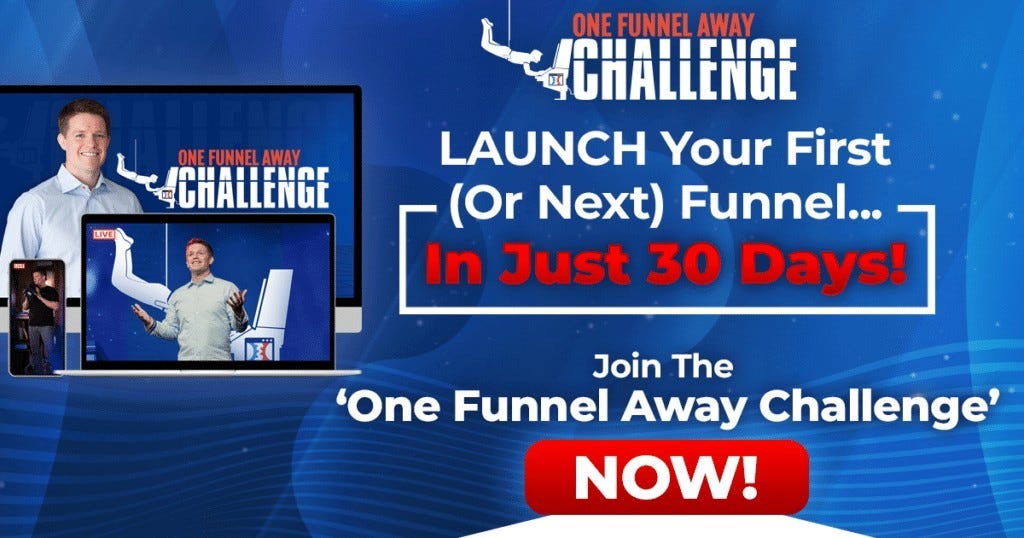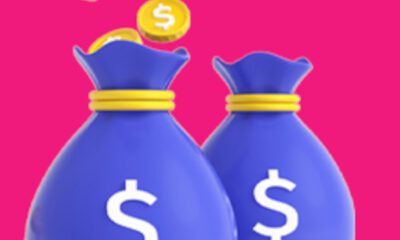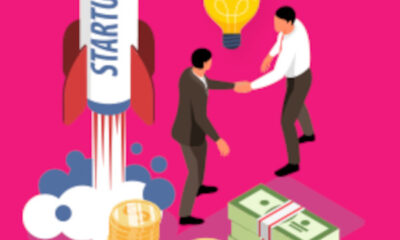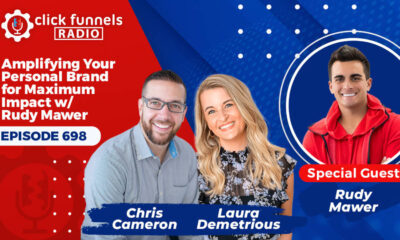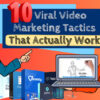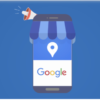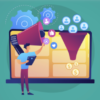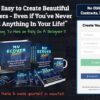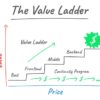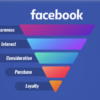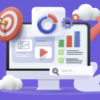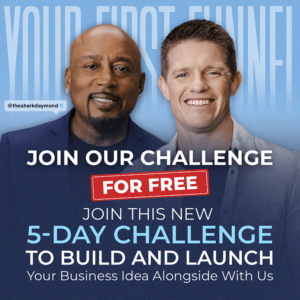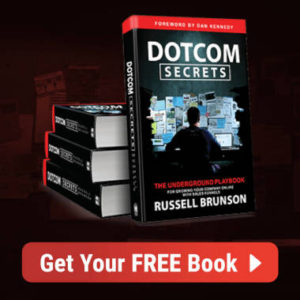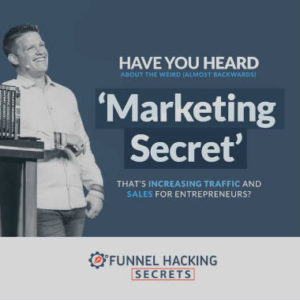Free
How To Create A Super High Converting Lead Magnet Funnel
The best way to get more leads is to offer potential customers something valuable in exchange for their email addresses. Today we are going to show you how to create a lead magnet funnel that converts well. Ready to take your lead generation efforts up a notch?
Keep reading…
What Is the Value Ladder Sales Funnel?
We believe that the most effective way to sell anything online is the Value Ladder sales funnel.
It was created by our co-founder Russell Brunson who then used it to take ClickFunnels from zero to $10M+ in annual revenue in just one year (it’s at $100M+ now!).
This sales funnel has four stages:
- Bait. You offer the potential customer your lead magnet in exchange for their email address.
- Frontend. You offer the potential customer your least expensive and least valuable product or service.
- Middle. You offer the customer a more expensive and more valuable product or service.
- Backend. You offer the customer your most expensive and most valuable product or service.
Ideally, you also offer a continuity program of some sort, meaning, a subscription product that generates recurring revenue.
We also recommend adding down sells, upsells, and cross-sells to these core offers in order to maximize your revenue.
The reason why this sales funnel works so well is that it allows you to:
- Start the relationship with that person by offering free value.
- Nurture that relationship by continuing to provide free value via email.
- Build trust by providing progressively more paid value at each stage.
Here’s how Russell explains it:
What Is a Lead Magnet Funnel?
Okay, so now you know what the Value Ladder sales funnel is all about, but what is a lead magnet funnel?
What Is a Lead?
A lead is a potential customer who has:
- Expressed an interest in your product or service.
- Given you their contact details.
Note that a person has to meet both of these criteria in order to be considered a lead.
Someone who has visited your website but hasn’t provided their contact details is not a lead.
And neither is someone whose contact details you have somehow obtained but who hasn’t indicated any interest in whatever it is that you sell.
That being said, this definition of the term “lead” only applies to lead generation, not sales prospecting.

What Is a Lead Magnet?
A lead magnet is a freebie that you offer to potential customers in exchange for their email addresses.
It can be anything that they can either download to their device or access online:
- A report.
- An ebook.
- A cheat sheet.
- An email course.
- A video course.
- A webinar.
…etc.
There’s also a type of lead magnet called the “FREE + Shipping” lead magnet that involves offering the potential customer a free physical product but asking them to pay for shipping.
Say, Russell has written three best-selling books, all of which you can get for free if you cover the shipping fees.
However, this is an advanced lead generation technique, which is why we don’t recommend it for your first lead magnet funnel.
It’s best to stick to digital lead magnets if you are just starting out.
What Is a Lead Magnet Funnel?
A lead magnet funnel, also known as a lead generation funnel, is a funnel designed to convert potential customers into leads by persuading them to give you their contact details.
It is the first stage of the previously discussed Value Ladder sales funnels called the Bait stage.
Once the potential customer gives you their email address, they enter your sales funnel and become a lead.
After that, your goal is to convert them into paying customers by getting them to progress to the Frontend stage of the Value Ladder sales funnel.
And after that, you want to convert them into repeat customers by getting them to progress to the Middle and the Backend stages of your Value Ladder sales funnel.
It’s extremely important to understand that the lead generation funnel doesn’t exist in isolation.
It’s just the first stage of the Value Ladder sales funnel and should always be viewed in that context.
The 3 Most Popular Variations of the Lead Magnet Funnel
There are several variations of the lead magnet funnel.
Let’s take a closer look at the three most popular ones…
Squeeze Page Funnel
A squeeze page funnel is the most basic variation of the lead magnet funnel that can work well for pretty much any business.
It has two pages:
- A squeeze page that explains what your free offer is all about.
- A thank you page that provides the link to the lead magnet.
We recommend starting with the squeeze page funnel if you have never built a lead magnet funnel before.

Reverse Squeeze Page Funnel
A reverse squeeze page funnel is a more advanced lead magnet funnel variation.
Just like the squeeze page funnel, it has these two pages:
- A squeeze page that explains what your free offer is all about.
- A thank you page that provides the link to the lead magnet.
So what’s the difference between the squeeze page funnel and the reverse squeeze page funnel?
The former keeps all free value behind an opt-in wall, meanwhile, the latter provides some free value upfront. What does that mean?
Let’s say that your business is in the fitness industry, specifically in the calisthenics niche, so you decide to offer a free video course that teaches people basic calisthenics skills.
If you were to use a squeeze page funnel, then you would ask people to provide their email addresses in order to get access to your video course.
However, if you were to use a reverse squeeze page funnel, you would feature one video from the course on the squeeze page itself, no opt-in required.
Then you would ask people to provide their email addresses in order to get access to the rest of the course.
Say, you could feature an introductory video that explains general calisthenics principles such as skill progressions on the squeeze page.
And then you could offer the potential customers free videos with step-by-step progressions for basic skills such as pushups, pull-ups, hanging leg raises, etc. in exchange for their email addresses.
Generally, reverse squeeze page funnels generate fewer leads than regular squeeze page funnels, but those leads tend to be of higher quality aka more likely to convert into paying customers.
Reverse squeeze page funnels require video lead magnets, so you might want to consider this approach if you are in an industry where the video is the best medium for providing free value (fitness, cooking, crafts, etc.).

Webinar Funnel
The webinar funnel is one of the most advanced lead magnet funnel variations.
It has these five pages:
- A webinar registration page where you encourage people to sign up for your free webinar.
- A thank you page where you provide information on how to attend the webinar (date, time, webinar link, etc.)
- The webinar page where people can join the webinar.
And if someone registered for the event but couldn’t make it, you can send them a link to the webinar replay page. - A sales page for your frontend offer. Note that you need to have a frontend product or service ready if you want to implement this lead magnet funnel variation. You should end your webinar by pitching your frontend offer.

The webinar funnel holds a special place in our hearts because that’s what Russell used to get ClickFunnels off the ground in our first year.
At the time, he would aim to do 5-7 webinars a week and would sometimes end up doing 2-3 webinars a day. Pretty crazy but it worked!
In fact, it worked so well that to this day, Russell is convinced that:
“The best business model in the world is to create a webinar selling your product or your service and then do that webinar live every single week for a year, at least once a week.”
Of course, doing it live isn’t absolutely necessary, so if the idea gives you anxiety then you can offer free access to pre-recorded events.
However, hosting live webinars can help you learn more about your target audience, improve your public speaking skills, and perfect your sales pitch.
Live webinar funnels are best suited for products and services that cost $50+ because hosting a live event requires a significant amount of not only time but also energy.
Meanwhile, pre-recorded webinar funnels can also work for much more affordable products, say, $7 ebooks.
After all, you only need to record the event once, so this approach doesn’t require nearly as much time and energy as running live webinars.
However, if you decide to go the pre-recorded webinar route, make sure that your attendees are aware that the event isn’t live.
Otherwise, they might feel cheated, which would be counterproductive to building trust.
And building trust is what the Value Ladder sales funnel is all about!
How To Build Your First Lead Magnet Funnel
Have you picked the lead magnet funnel variation that is most suitable for your business?
Now it’s time to build your first lead magnet funnel…
Step #1: Create a Super Valuable Lead Magnet
As we have mentioned previously, a lead magnet can be anything that the potential customer can either download to their device or access online.
What’s important is that:
- Your lead magnet provides a solution to a problem that the potential customer is struggling with.
- That problem is either the same one or related to the one that your frontend product addresses.
You know how in supermarkets you sometimes see those stalls where you can get free food samples, then buy that food item if you like it?
Ideally, your lead magnet should serve as a free sample of the value that your front-end product provides.

Step #2 Create a Landing Page for Your Lead Magnet
Your lead magnet needs a landing page.
All three previously discussed lead magnet funnel variations use squeeze pages which are the most basic type of landing pages.
Your squeeze page should have these three key elements:
- A headline that conveys the value of your free offer.
- An opt-in form where the potential customer can type in their email address. It can either be shown immediately or displayed once they click the call-to-action button.
- A call-to-action button that encourages the potential customer to get the lead magnet.
Obviously, if you are using the reverse squeeze page funnel, then your squeeze page should also include a free video.
You might also want to experiment with various additional elements such as extra copy, social proof, relevant images, etc. Just make sure to A/B test everything!
Here’s a simple, yet high-converting squeeze page that we use for our “The Funnel Hacker’s Cookbook” lead magnet:
Step #3: Start Driving Traffic to Your Lead Magnet Landing Page!
You can’t know whether your free offer resonates with your target audience until you start driving traffic to its landing page.
Set up a paid advertising campaign on Facebook, start running ads with a small daily budget, then see what happens. Are people giving you their email addresses?
And if you already have the Frontend stage of your sales funnel built out, then see whether those leads are converting into paying customers. Is your ad campaign profitable?
Only start scaling your ad campaign once you are sure that your ideal customers are interested in whatever it is that you are offering.
Also, in the long run, you don’t want to be completely reliant on paid advertising. You should build your own traffic-generating assets such as a social media following, a blog, a YouTube channel, etc.
But in the short run, you need to get traffic ASAP and paid advertising is the best way to do it.
So figure out how to profitably run ads first, then start experimenting with other marketing channels.
How To Convert Leads Into Paying Customers
Okay, so now that your lead magnet funnel is up and running, you should be getting some leads. But how can you convert them into paying customers?
You need to build out the next stage of your sales funnel which is known as the Frontend stage.
Here’s how:
Step #1: Create an Irresistible Frontend Offer
It’s important to understand that the primary purpose of your frontend offer isn’t to make you loads of money, it’s to convert leads into paying customers.
That’s why we recommend:
- Make sure that there’s a natural progression from your lead magnet to your frontend offer.
- Pricing your frontend offer within the impulse buy range. $7 is a price point that works best.
- Offering a 60-day no-questions-asked money-back guarantee.
For example:
Matthew Hussey, a world-renowned dating coach, has a lead magnet called “9 Magic Texts No Man Can Resist”.
It’s a guide that provides nine text message scripts that women can copy-paste when texting guys they like.
Meanwhile, his frontend product is a guide called “The Momentum Texts” that provides 67 more text message scripts.
So if a woman found the free scripts useful, she will likely be inclined to check out the paid scripts.
Especially given that “The Momentum Texts” only costs $7 and comes with a 60-day no-questions-asked money-back guarantee!
See how there’s a seamless progression from the lead magnet to the frontend product?
You want that in your sales funnel!

Step #2: Create a Sales Page for Your Frontend Offer
Your front-end offer needs a sales page.
A short-form sales page is enough given that this is a $7 product.
Sales page copywriting is a huge topic that we can’t possibly cover in just a few paragraphs.
But we want to share a few tips that can help you create a sales page that converts well even if you don’t have any previous copywriting experience:
Focus on Benefits, Not on Features
The distinction between features and benefits is one of the most important copywriting principles:
- A feature is a function or a quality of a product (e.g. “These shoes are waterproof!”).
- A benefit is a value that the customer will derive from that product (e.g. “These shoes will keep your feet dry!”).
People buy based on benefits, which is why you should emphasize them all throughout your sales copy.
Your headline, your sub-headline, your body copy, everything should be benefit-driven.
Have a Powerful Headline
David Ogilvy, one of the most famous copywriters that ever lived, has said:
“On the average, five times as many people read the headline as read the body copy. When you have written your headline, you have spent eighty cents out of your dollar.”
Your headline is the most important component of your sales page, so make sure that it clearly conveys the #1 benefit of your front-end product.
How will it make the potential customer’s life better?
Focus on that!
Use the Hook, Story, Offer Copywriting Framework
We recommend using the “Hook, Story, Offer” copywriting framework on your sales page:
- Hook. Grab the potential customer’s attention with your headline.
- Story. Tell them a captivating story that resonates with them on an emotional level in the body copy.
- Offer. Transition from the story to your pitch and end your sales page with a clear call to action.
Here’s how Russell explains it:
By the way, if you want to learn more about copywriting, check out Jim Edwards’ book “Copywriting Secrets”.
You can get it for FREE if you cover the shipping!
Step #3: Create a 6-Email ”Indoctrination” Sequence
We don’t recommend hitting the potential customer with a sales pitch the moment they give you their email address.
Send them this email sequence instead:
- Email #1: Who are you? Introduce yourself to the new subscriber.
- Email #2: Where did you come from? Tell your new subscriber your “origin story”. How did you come to do what you do now?
- Email #3: What do you do? Explain in more detail what it is that you do.
- Email #4: How did you gain this expertise? Explain what makes you qualified to do what you do. Mention relevant experience, accomplishments, credentials, etc.
- Email #5: Who do you do this for? Explain who are your ideal customers + share a case study on how you helped such a person get the results that they wanted.
- Email #6: How can you do it for me? Either pitch your frontend product or provide a “buffet” of links to all your offers if you already have your Value Ladder fully built out.
For emails #1 to #5:
End each email by asking the new subscriber a question, then encouraging them to hit the reply button and send you their answer.
For email #6:
End it either by encouraging the new subscriber to learn more about your front-end product or by encouraging them to check out each “buffet” item.
And don’t forget to use the “Hook, Story, Offer” framework in all six emails!
3 Simple Tricks To Increase Your Sales Funnel Revenue
Want to increase your revenue?
Add order bumps, upsells, and cross-sells to your sales funnel:
- An order bump is a small, no-explanation-required offer that you present to the potential customer when they have already entered their credit card information but haven’t checked out yet.
You know how in supermarkets there are all these sweets in the checkout area? Order bumps are the digital equivalent of KitKats that you throw in your cart without a second thought.
Say, if your frontend offer is a physical book, you could add an ebook and an audiobook as order bumps. Everyone already knows what these are, so there’s no need to explain anything. - An upsell is an upgraded version of the offer that the potential customer has already accepted (e.g. McDonald’s’ infamous “Would you like to supersize that?”).
That could mean offering a larger quantity, more features, a subscription, etc. Of course, for an upsell to be appealing, it must genuinely be a great deal! - A cross-sell is an offer that is complementary to the offer that the potential customer has already accepted (e.g. McDonald’s’ famous “Would you like fries with that?”).
Say, if you sell an info product such as an ebook or an online course, you could offer a 60-minute one-on-one consultation as a cross-sell.
Our software makes it super easy to add bump orders, upsells, and cross-sells to your sales funnel.
Doing that will almost certainly help you increase your revenue!

Want Russell To Show You How To Build Your First Sales Funnel?
Let’s keep it real:
Building a sales funnel from scratch can seem like a daunting task.
That’s why we created our 5-Day Challenge where Russell walks you through it step-by-step.
You will learn how to:
- Generate unlimited leads.
- Create your first lead magnet.
- Build your first sales funnel.
- Create a simple 6-email follow-up sequence.
- And launch your funnel!
…in just five days.
So don’t hesitate.
Click the link below if you’re ready for the next step — to build your high-converting sales funnel that will make the most of your marketing efforts!
>>>Launch Your First (Or Next) 7 Figure Funnel In 10 Minutes Or less!
>>>Join The One Funnel Away Challenge<<<





